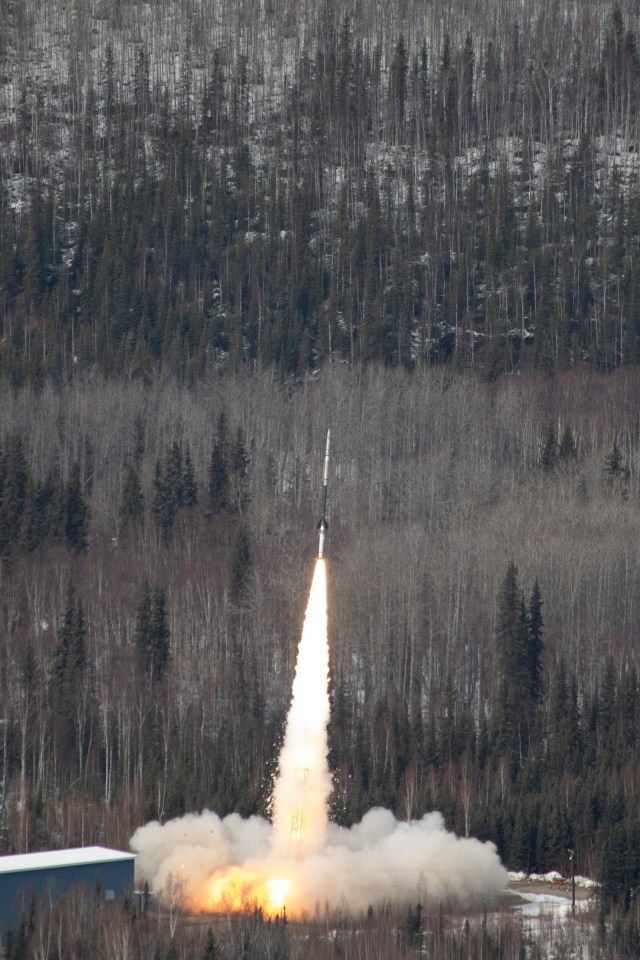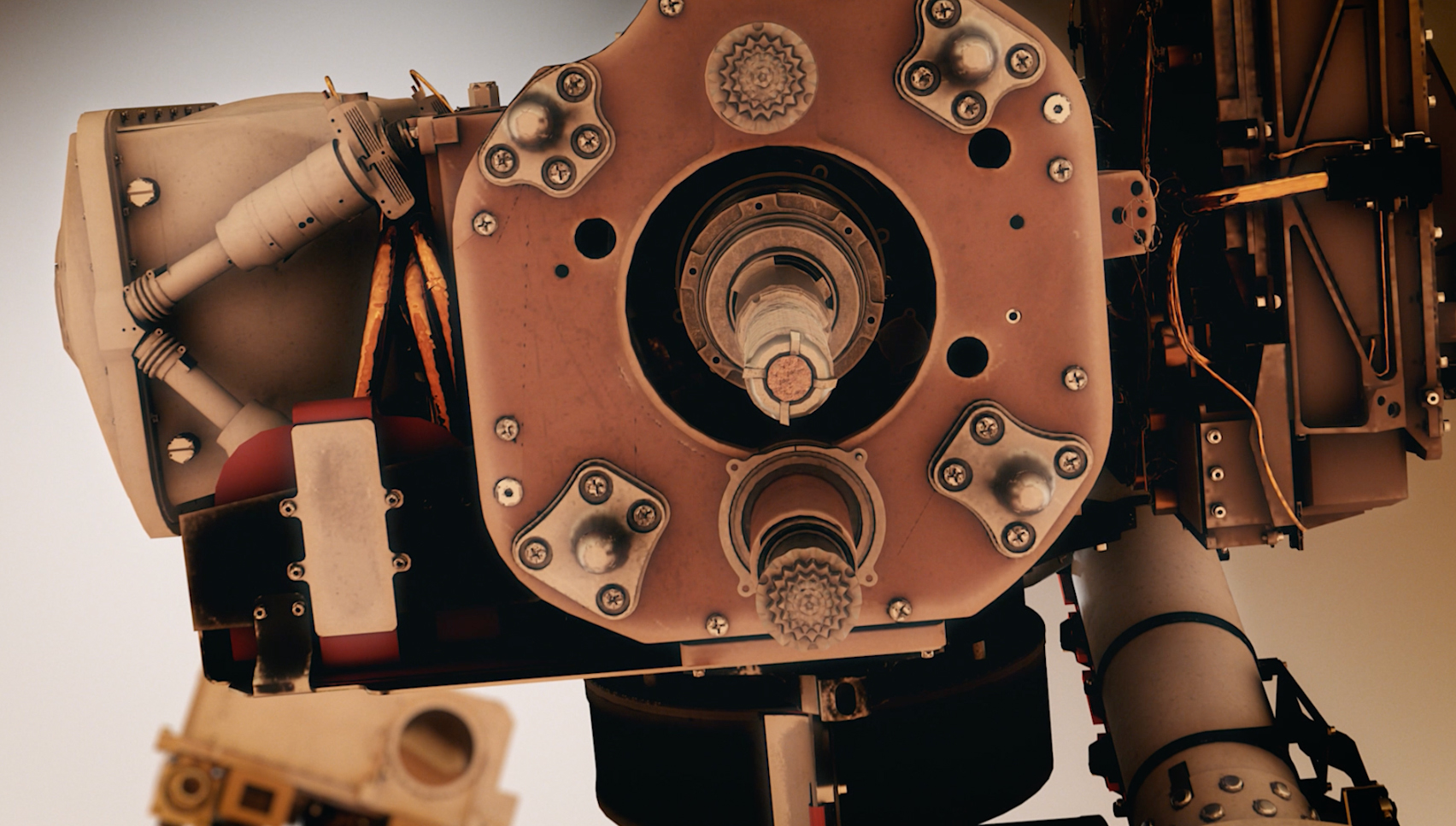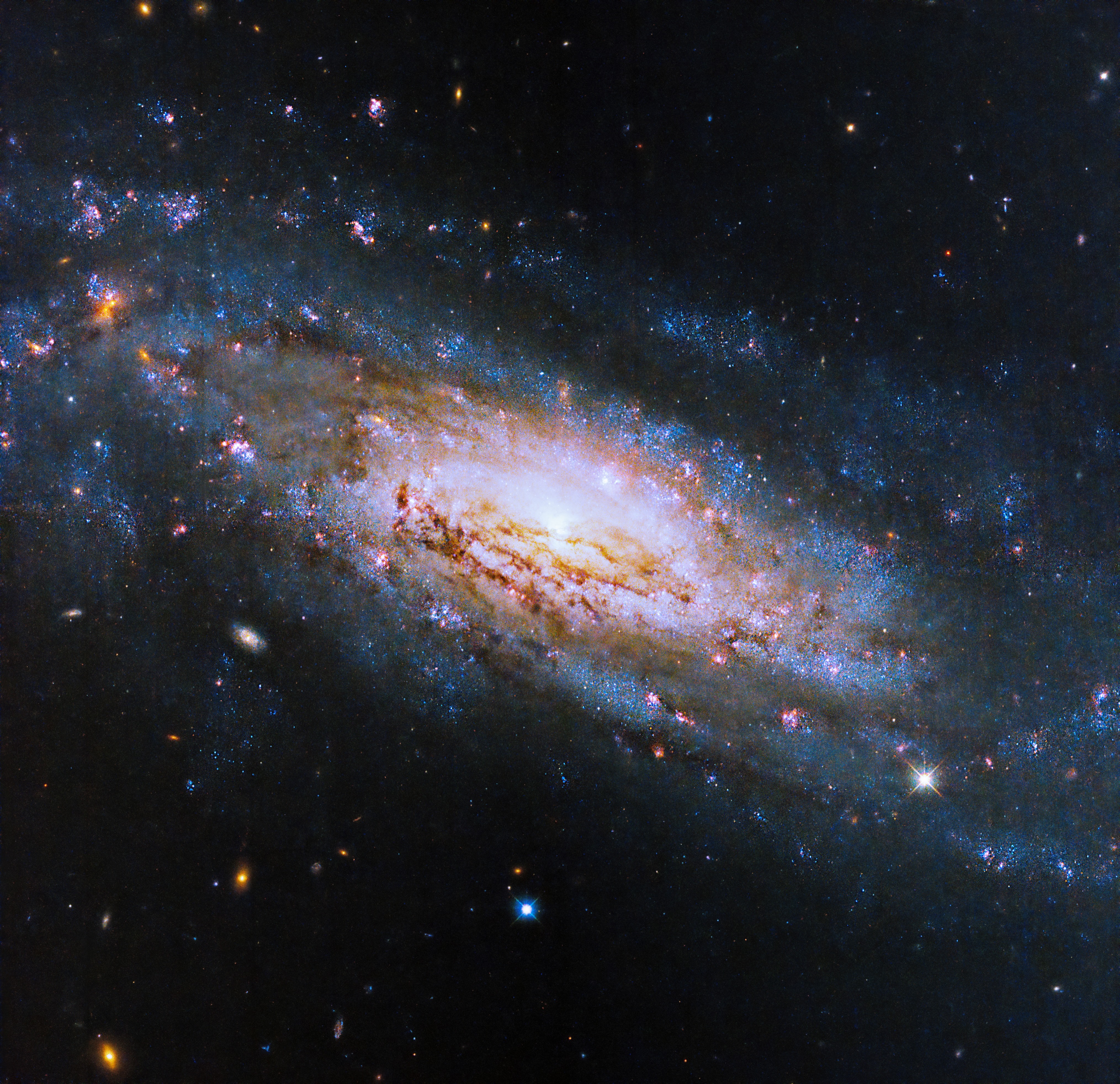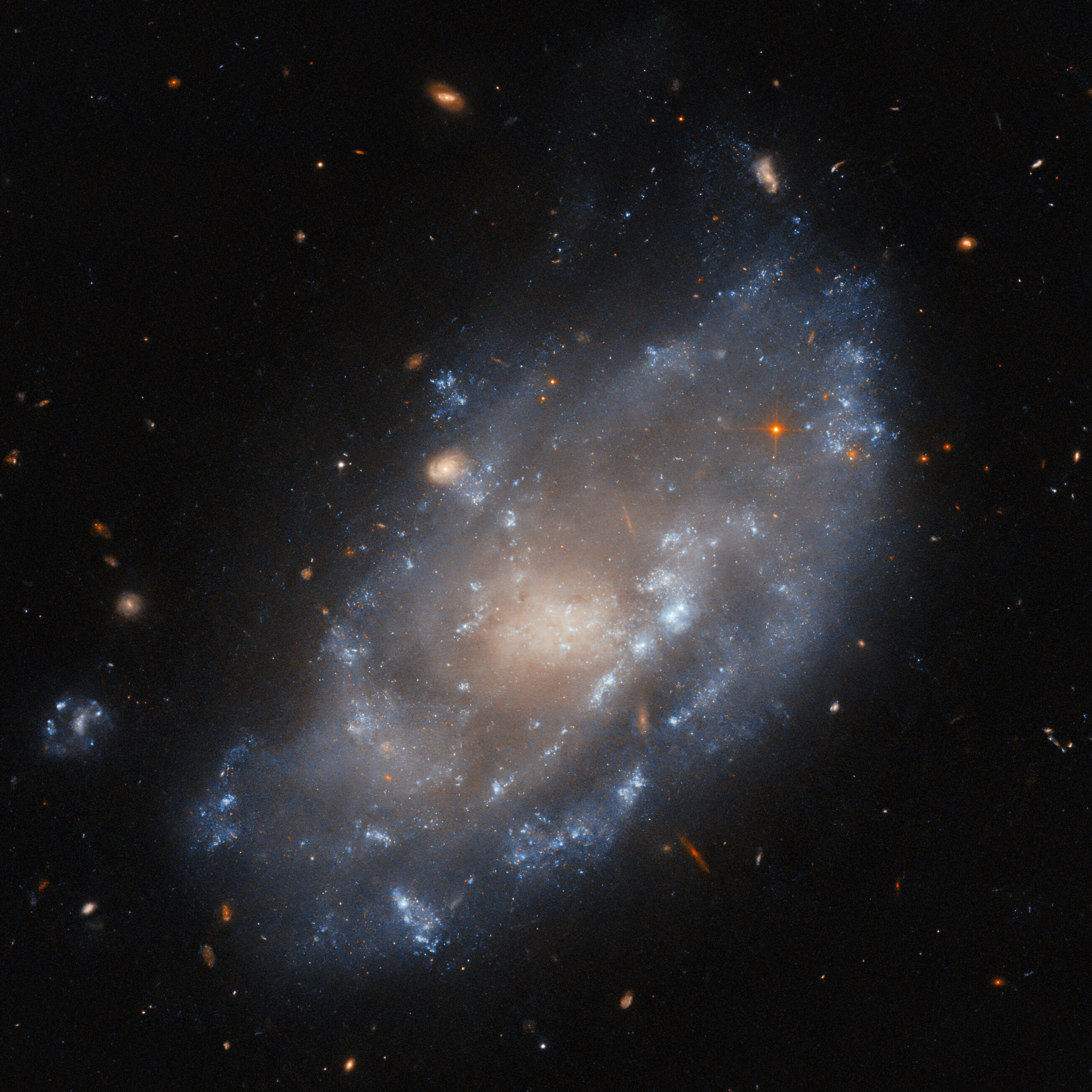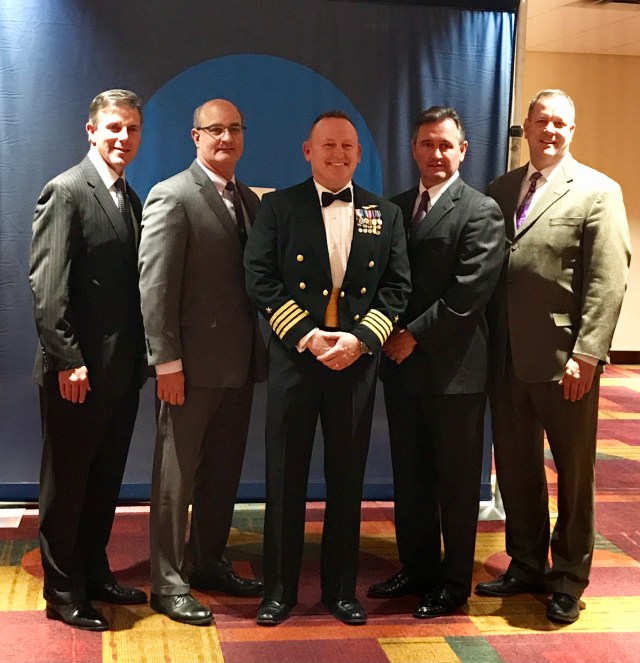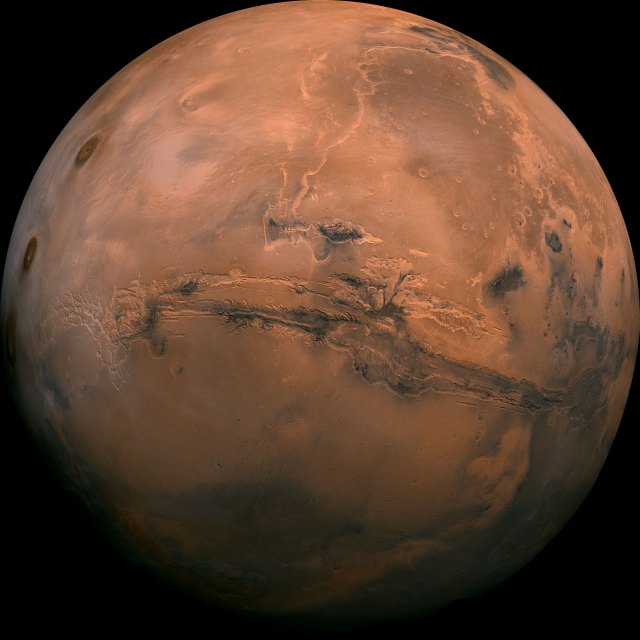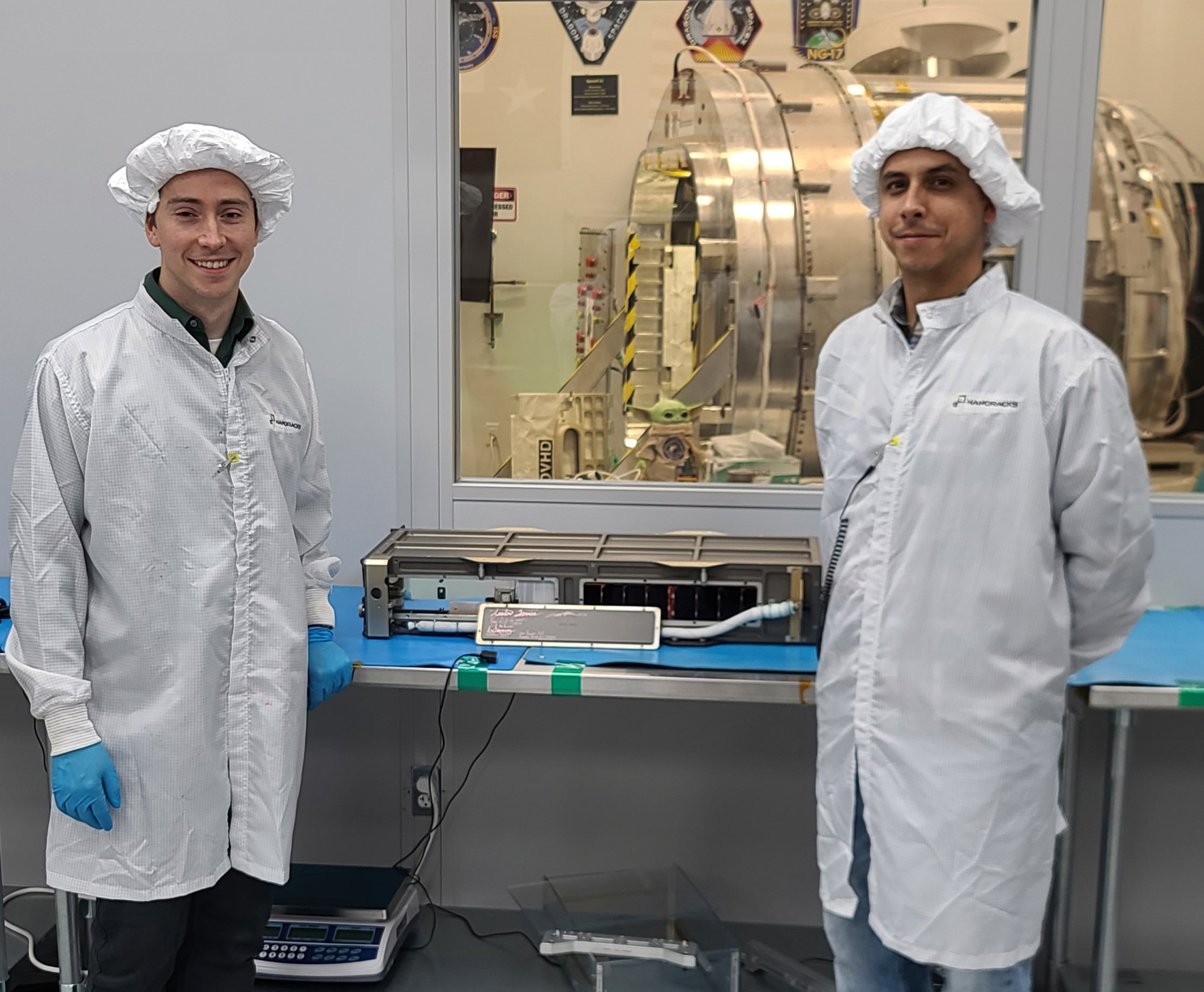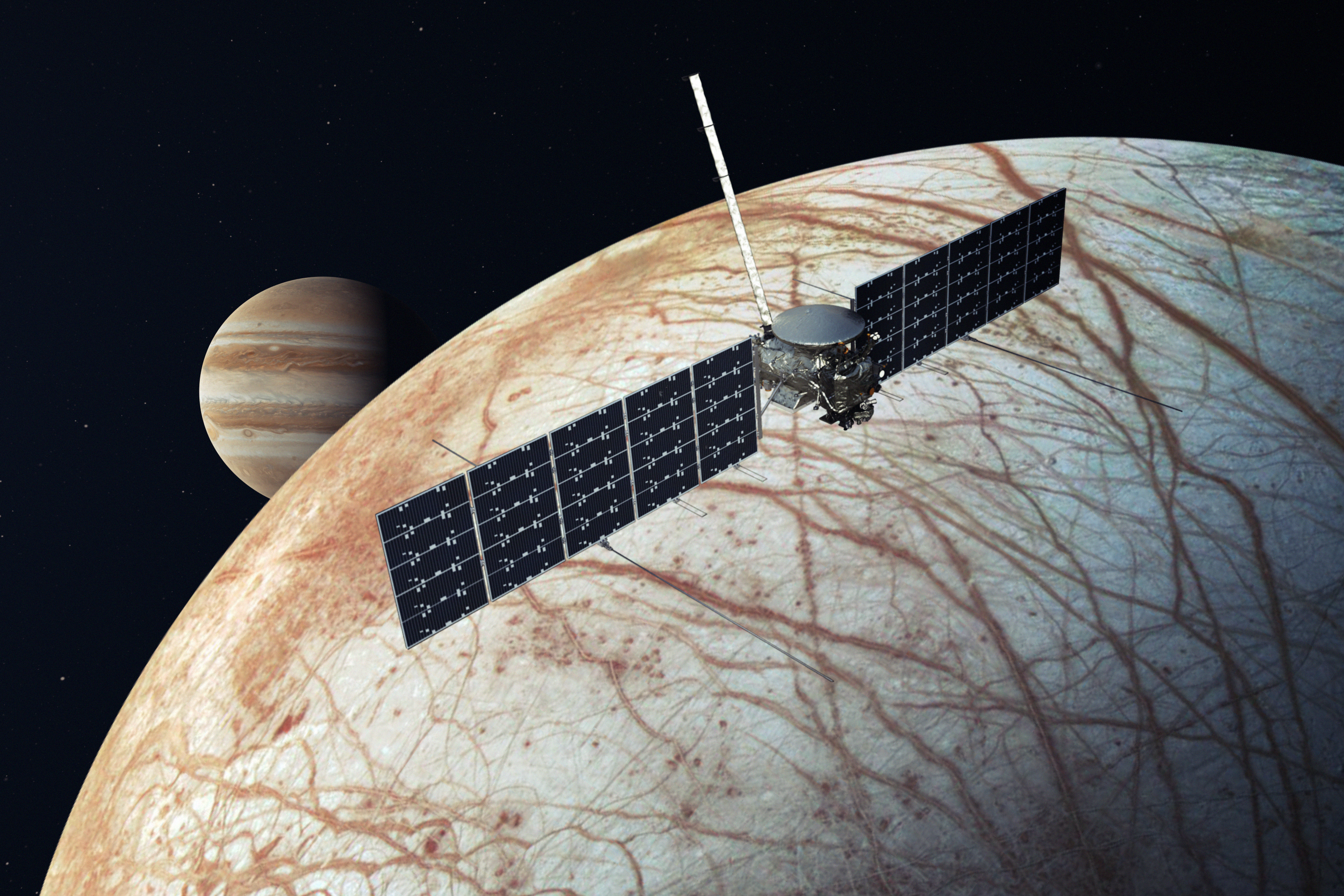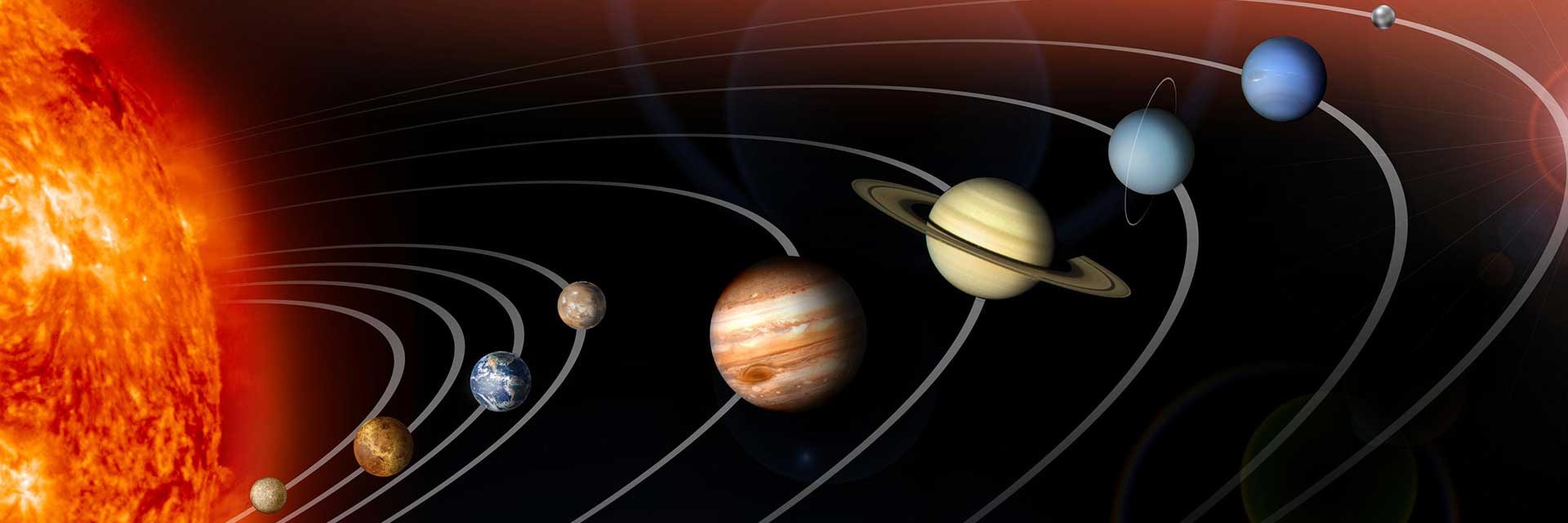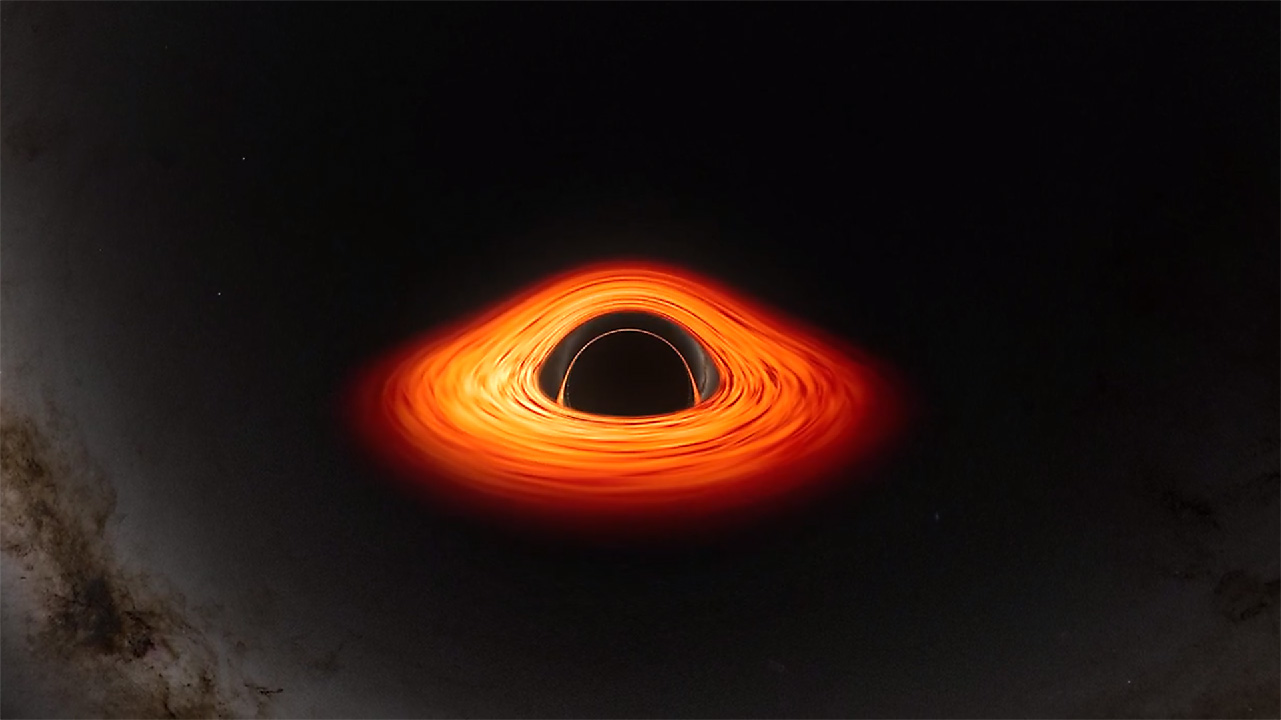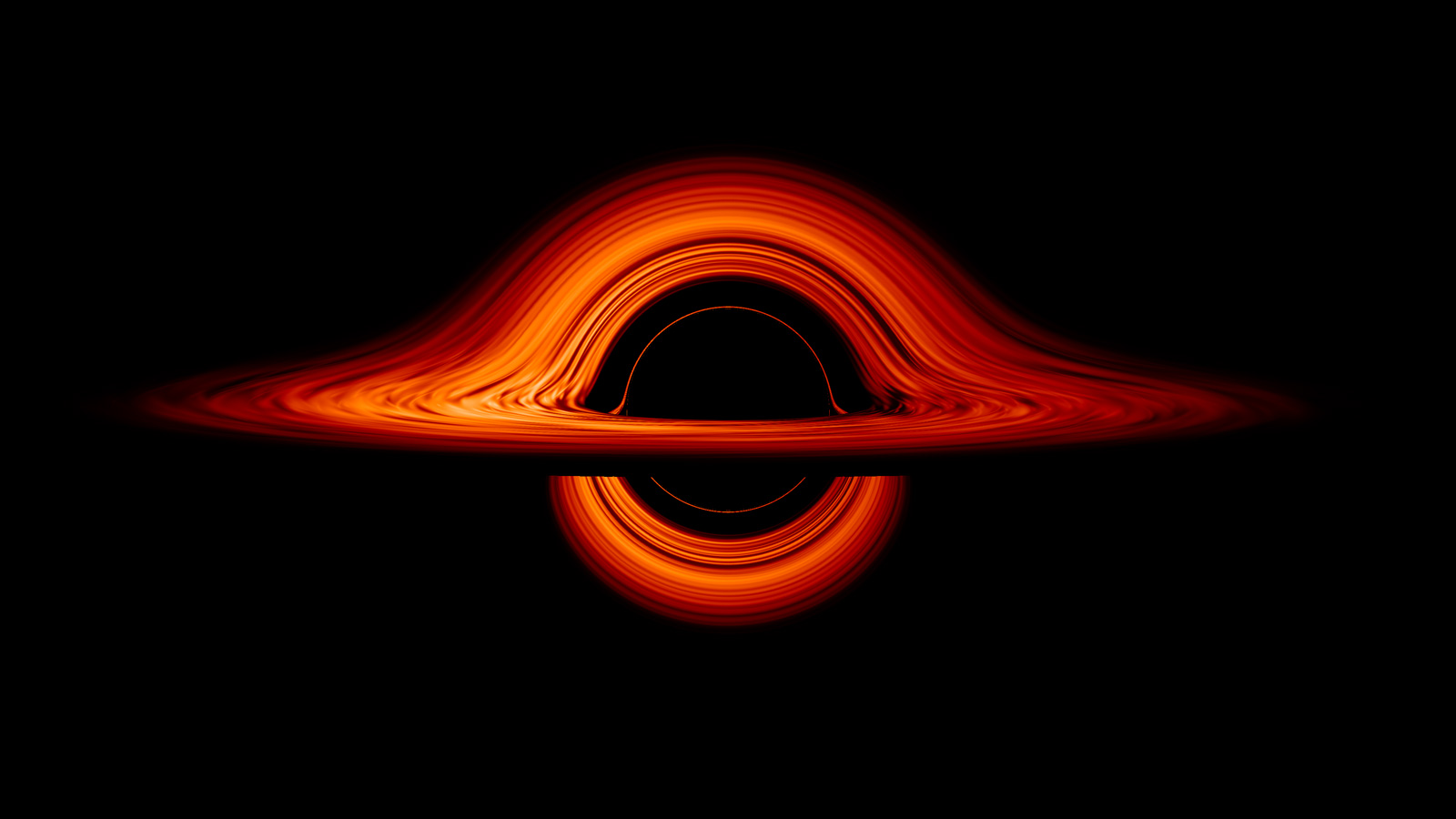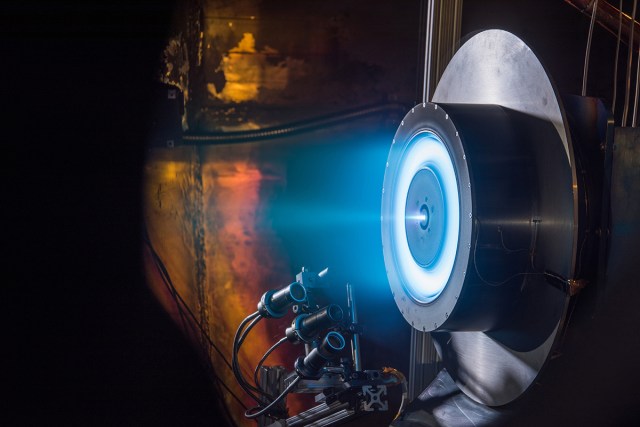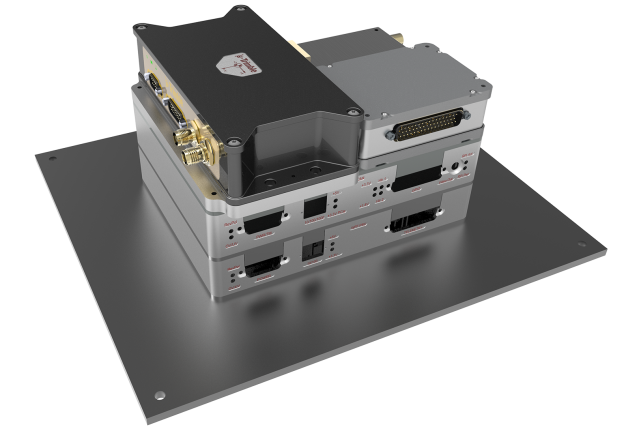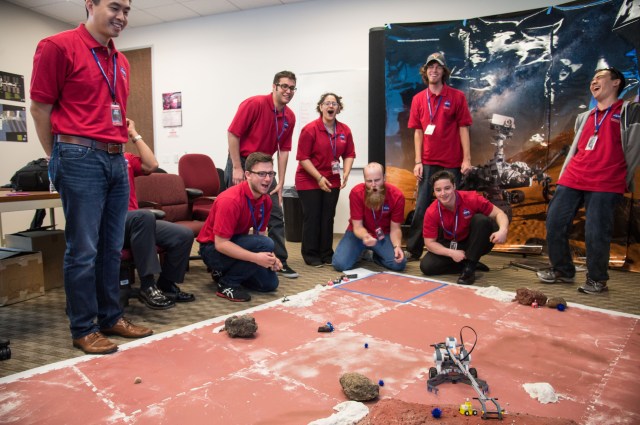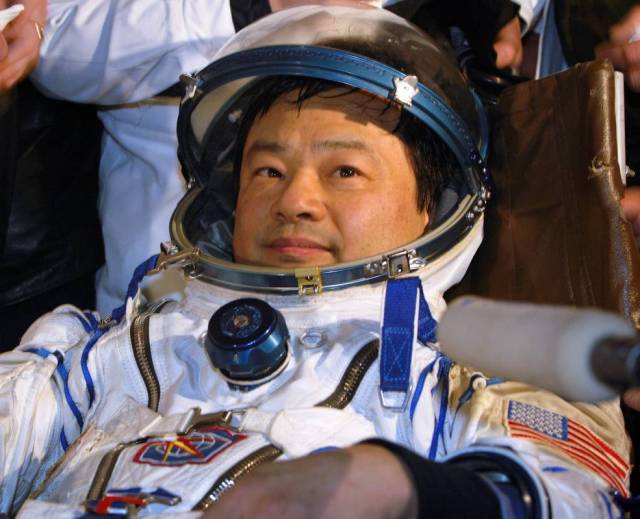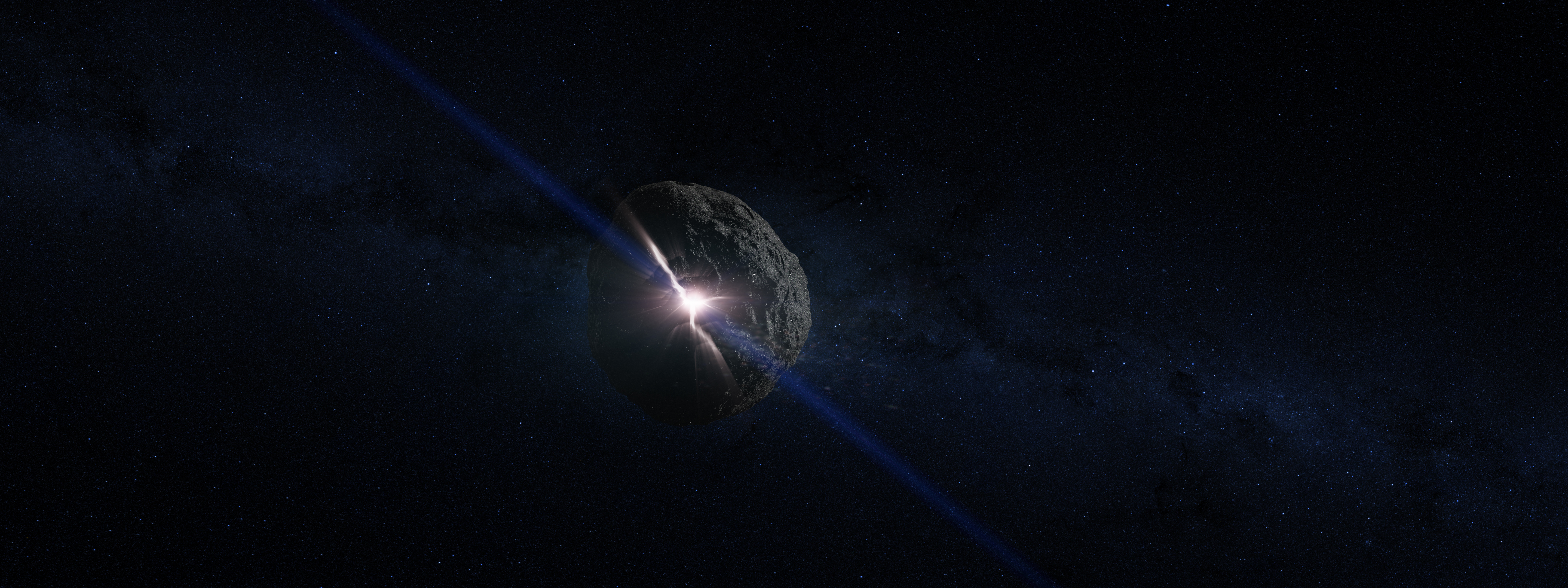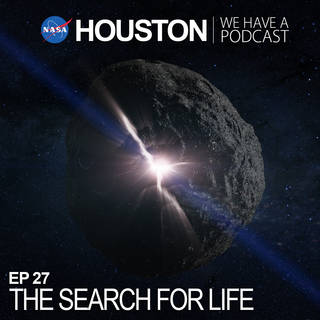
“Houston We Have a Podcast” is the official podcast of the NASA Johnson Space Center, the home of human spaceflight, stationed in Houston, Texas. We bring space right to you! On this podcast, you’ll learn from some of the brightest minds of America’s space agency as they discuss topics in engineering, science, technology and more. You’ll hear firsthand from astronauts what it’s like to launch atop a rocket, live in space and re-enter the Earth’s atmosphere. And you’ll listen in to the more human side of space as our guests tell stories of behind-the-scenes moments never heard before.
Episode 27 features Dr. Aaron Burton and Dr. Marc Fries, Planetary Scientists, who talk about searching for organic material in meteorites from around the solar system. They share what we’re finding that helps us understand the fundamentals of life here on Earth and possibly the universe. This episode was recorded on November 28, 2017.
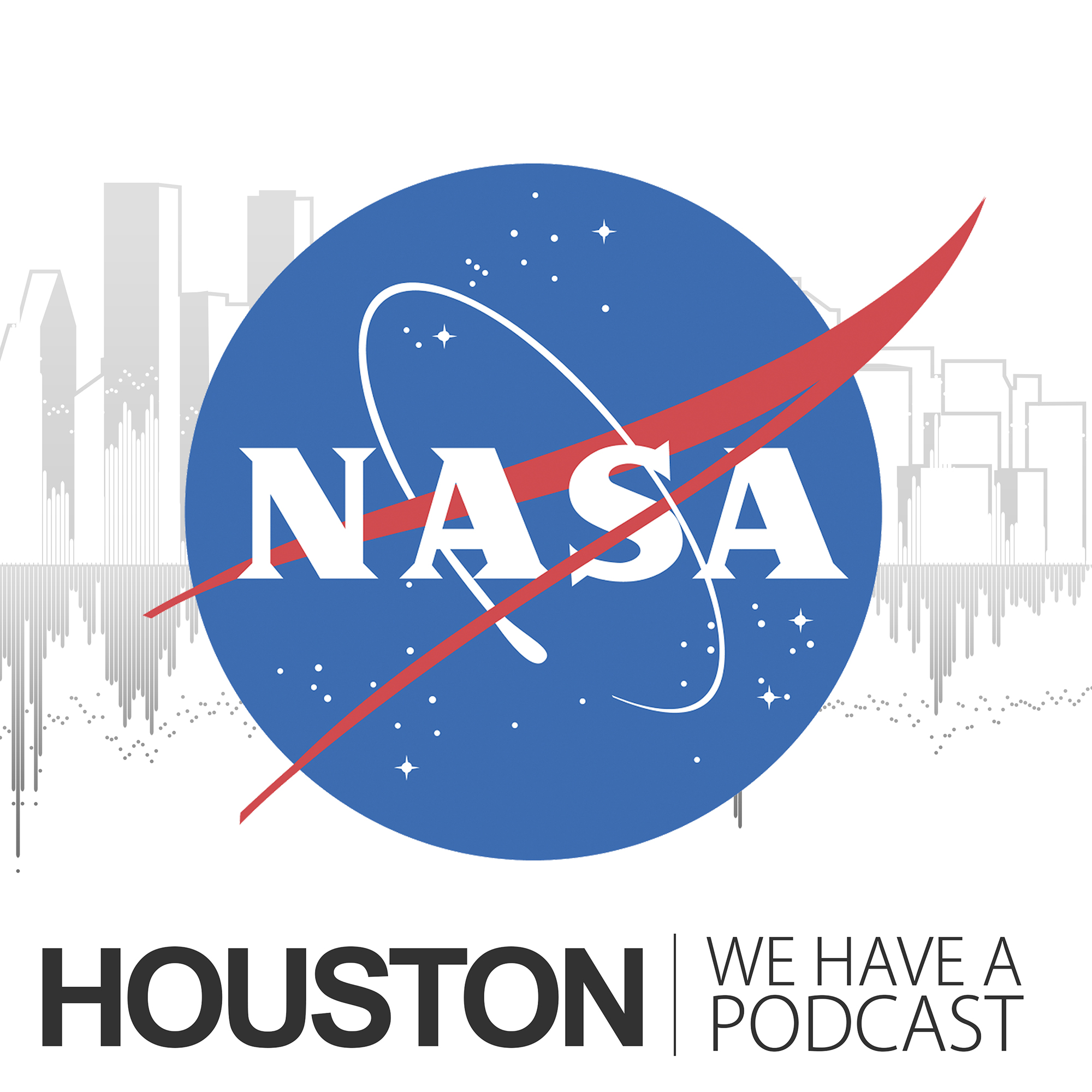
Transcript
[00:00:00]
Gary Jordan (Host): Houston, We Have a Podcast. Welcome to the official podcast of the NASA Johnson Space Center, Episode 27, The Search for Life. I’m Gary Jordan, and I’ll be your host today. So this is the podcast where we bring in the experts — NASA scientists, engineers, astronauts — all to tell you the coolest information about NASA and about space. So today we’re talking about something super cool, how we’re looking for life in the universe. We’re talking with Aaron Burton and Marc Fries. Aaron and Marc are both planetary scientists here at the NASA Johnson Space Center in Houston, Texas. And we had a great discussion about the different NASA initiatives all looking at organic material in the solar system and what we’re finding from these studies that help us understand the fundamentals of life here on Earth and possibly in the universe. So with no further delay, let’s go light speed and jump right into our talk with Dr. Aaron Burton and Dr. Marc Fries. Enjoy.
[00:00:50]
[ Music ]
[00:00:57]
>> T minus five seconds and counting. Mark.
[00:01:05]
>> [Inaudible] there she goes.
[00:01:06]
>> Houston, we have a podcast.
[00:01:08]
[ Music ]
[00:01:14]
Host:Well, this one’s going to be good because — I’m excited because this one’s about the ultimate question, right? Are we alone in the universe? That’s literally — I mean, it’s in the NASA mission statement, right? Everything we do is to explore the unknown and — reveal the unknown for the benefit of humankind or something like that. So I guess I’ll start off with this question: How many times a day do you ask yourself that question, “Are we alone?”
[00:01:40]
[ Laughter ]
[00:01:42]
Marc Fries: Well, it’s back there, you know, squirrel caging around somewhere all the time.
[00:01:46]
Host:Yeah.
[00:01:46]
Marc Fries:I don’t know if I stop in, like, the middle of shaving and go, “Wait a minute, but are we alone?” But, you know, I do think about it on a regular basis, sure.
[00:01:54]
Host:I figure, well, because that’s the whole thing, right? This is your job. Your job is to look for organic material, right? So I guess to just pull back. And I just think that would be super cool, are we alone or — you know, that’s not bad.
[00:02:06]
Aaron Burton: You know, I’d say I think about it more at night. Well, when you look up at the stars and you just see all of the stars.
[00:02:13]
Host:Okay.
[00:02:13]
Aaron Burton: That’s just what we can see.
[00:02:15]
Host:Yeah, exactly.
[00:02:16]
Aaron Burton: So the thought that we’re the only game in town seems a pretty — pretty unlikely.
[00:02:21]
Host:Yeah. I just took a camping trip out to Big Bend a couple weeks ago. And that was just an eye-opener. Because I thought I had seen, “Wow, there’s a lot of stars in the sky,” you know, when I was living in Pennsylvania. But out in Big Bend you can see the Milky Way. And there’s constellations where you couldn’t even see them because there was just that many more stars. It was just the clearest sky I’ve ever seen in my life. I was like, “Wow, this is just — from a different part of Earth I can see this many stars.” It was crazy. All right. Well, so let’s start off with just a little bit about you guys and since you’re both planetary scientists kind of what your focuses are.
[00:02:59]
Aaron Burton: Okay. Yeah. So I have built a research lab where we look for organic molecules that we find in meteorites. So these are carbon-containing molecules. And I’m interested in the ones that are related to biology. So things that biology could use. And so by looking at the organic molecules that are found in meteorites, that gives us a way to look at samples where biologically interesting molecules are made but they weren’t made by life. They were just made by sort of abiotic chemistry, things that can happen in our solar system. And so I’m interested in doing that because I want to know about the chemistry that was going on before life started. And then from understanding that chemistry, try and take the next step forward to think of if we know the chemistry that was going on without life, how did that transition into a living system that we have?
[00:03:53]
Host:Wow. Literally the origins of life.
[00:03:56]
Aaron Burton: Yeah.
[00:03:56]
Host:That’s pretty cool. How about you, Marc?
[00:03:59]
Marc Fries:I work in curation. I’m a scientist in curation. And then curation I should explain. We basically take care of NASA’s collections. We have the Apollo moon rock collection, we have meteorites from Antarctica, we have samples from — delivered by a couple sample return missions. And all the curators, all the curation scientists are expected to have a scientific interest as well and maintain a scientific course of study. What I study is carbon in geological systems, not necessarily just organic chemistry. Aaron’s much more of a specialist in that, much more of an expert in that than I am, per se. But more of carbon in entire systems ranging from, you know, gas phase carbon that you find in rocks, whether it’s biological or geological carbon is part of a system on planetary surfaces and interiors and such.
[00:04:54]
Host:But it’s fair to say, you know, carbon is an essential component of life, right?
[00:05:00]
Marc Fries:As far as we know, yes.
[00:05:01]
[ Laughter ]
[00:05:02]
Host:That’s true. There’s a bunch of other things, you know, that we can talk about. I don’t know — I don’t know if you guys actually discuss silicon-based life forms or anything like that or —
[00:05:12]
Aaron Burton: Yeah, I —
[00:05:12]
Host:— I would say carbon. Carbon’s usually the good stuff, right? That’s the basic form of life.
[00:05:18]
Aaron Burton: Yeah. So at the most simple aspect you have carbon, and we like it because it make four bonds. So you can make these long polymers out of it. And so if you just go down the periodic table, silicon, well, that does, you know, similar things.
[00:05:31]
Host: Right.
[00:05:32]
Aaron Burton: But carbon’s actually pretty special. So if you compare carbon and silane or methane and silane — so metaion is CH4, silane is SIH4. You know, those would be sort of the analogous molecules. By silane actually is, like, an incredibly explosive gas. And it’s very difficult to keep on Earth, whereas methane, you know, sort of hangs around and gets produced. So that works out well for organisms that produce methane and for life. And then if you start looking at other things like CO2 as a gas, that’s what we breathe in and breathe out, you know, trees use that for photosynthesis. If you compare that SIO2, you know, that’s —
[00:06:14]
Marc Fries:It’s a rock.
[00:06:15]
Aaron Burton: [Laughs] Yeah, that’s a —
[00:06:15]
Marc Fries:Kind of hard to breathe rock.
[00:06:17]
Aaron Burton: [Laughs] Yeah, it’s — yeah. So it’s hard to breathe. It’s not very easy for organisms to process it or to access it. And so, you know, it ends up being just a less mobile sort of building block. If you’re whole life was centered around silicon, now it’s all sand, right?
[00:06:34]
Host: Yeah, a little harder. So carbon is just the magic ingredient, really, just because that ability to bond to so many things.
[00:06:43]
Aaron Burton: Yeah, at least based on physics in our solar system.
[00:06:48]
Host: Well, so, you know, the whole just concept of life, searching for life, right? I mean, there’s a lot of things that we study out in the universe, but this quest to find life outside the solar system, why is that so fundamental to us as humans, to go out and to search for it?
[00:07:06]
Marc Fries:It’s a good question, kind of hard to answer because it’s just kind of — best answer I could give is that it’s just a fundamental question. I mean, anybody’s who’s looked up at night, like Aaron said, has had to wonder. You know, there’s an awful lot of stuff up there. Surely there’s got to be something else. It’s just a basic, almost primal human query. I don’t know how to put it any better than that, honestly.
[00:07:34]
Host: Yeah.
[00:07:35]
Aaron Burton: Yeah. I mean, I think it’s kind of like the human tradition of exploring. And, you know, first it started out, you know, humans on a land mass. And they said, “Well, what’s on the other side? You know? What’s over those mountains?”
[00:07:46]
Host: Right.
[00:07:47]
Aaron Burton: What’s across that river? And then expanded to what’s across that ocean? And then what’s at the bottom of the sea floor? And now, you know, what’s on the next world over? And, you know, it’s kind of that exploring but also then, you know, if we’re asking these questions, is there anyone else out there that’s asking those same questions?
[00:08:06]
Host: Yeah. That’s true. I mean, if you think about human history, just the fact that people travel, they find a new civilization and can open up new trade routes. Or even as far as cross the Atlantic Ocean and discover a whole new world trying to find more trade routes or something like that. So it’s just — I guess you’re right, it’s kind of built into our DNA that we just have this drive to — it’s not enough, right? We want to — we want to know. We want to know why. We want to know more.
[00:08:33]
Aaron Burton: Yeah. You look at the sky and you say, “I’m pretty sure there’s life out there. but I want to sort of prove it.” You know?
[00:08:37]
Host: Yeah.
[00:08:38]
Aaron Burton: I want to find it, actually know.
[00:08:40]
Host: Pretty sure is not good enough [Laughs].
[00:08:42]
Marc Fries: Luckily humans have a low fascination threshold.
[00:08:46]
[ Laughter ]
[00:08:48]
Host: So — so I mean, just besides the fascinating of it, why is it important to understand the origins of life? You know, what can we get out of it?
[00:08:59]
Aaron Burton: Well, for me, you know, I’ve just been interested, I guess, from the scientific standpoint of, you know, how does life start? Which I think naturally leads to could life exist elsewhere? And so those are two kind of the basic questions. Because if life could exist elsewhere, then that answers your sort of fundamental, intrinsic question of is there life elsewhere? If you know how it started, then you know what signs to look for, what kinds of environments you need to look in, what types of chemistry needs to be going on for you to look there for life.
[00:09:34]
Host: So how does just — you know, once you do that, you know, I guess you can help you search for life outside, but what about here on Earth? You know? Is there applications for, you know, learning more about how the origins of life and how that comes to be? How can that help us here?
[00:09:51]
Marc Fries: See, I would answer that by saying that, you know, fundamentally we’re answering — it’s like we said, like [inaudible] talked about just a minute ago, this understanding the origin of life is one of primal fundamental human queries that most people want to know. And as scientists, our goal, our purpose is to discover exactly that sort of thing, to try to answer those sort of questions, to be the interpreters of the world around us, to try to enrich everyone’s lives. And that’s a really important thing that a lot of people are interested in. So it’s a high priority for scientific investigation. For a more nuts and bolts approach, you know, maybe understanding the fundamentals of how life arose would give us better understanding into our own biochemistry at a very fundamental level. That’s a possibility.
[00:10:49]
Host: Improving life for us, you know, making life better for humans. Just however — you know, bring it into industry, make better drugs or understand how, you know, people grow up or develop. You know, just life, right?
[00:11:03]
Marc Fries: The fundaments of how a cell functions on the chemical level. It can’t be bad to know more about that.
[00:11:11]
Host: [Laughs] Well, talking to —
[00:11:13]
Aaron Burton: I would —
[00:11:13]
Host: Oh, go ahead.
[00:11:14]
Aaron Burton: Sorry. So I would just add that a lot of what origins of life researchers try to do is sort of recreate how life could have started. You know, ideally if you had a time machine, you would just go back in time 4.5 billion years —
[00:11:28]
Host: Oh, that would be easy [Laughs].
[00:11:29]
Aaron Burton: — to the start of life. But it raises a philosophical issue, which is what if you disrupted that process and so you actually killed life? So maybe that’s a bad idea. But, you know, without a time machine we don’t have to worry about that. But the best we can hope to do is sort of recreate how life started or how life could have started. And so a lot of the experiments that have gone on in there have looked at sort of alternatives to DNA. And so these alternatives to DNA have actually been shown to not be recognized by sort of modern biology. So you can make sort of a drug out of this alternative DNA that now has a longer lifespan inside of a human. You know? So it’s kind of expanded the range of drugs that are accessible and kind of opened up or helped contribute to the field of synthetic biology where we can start, you know, doing gene manipulation, genetic therapies. So there really are practical applications of it in addition to satisfying our kind of curiosity about how life started.
[00:12:32]
Host: Just out of curiosity, these studies, are there any going on, on the International Space Station right now that have to do with sort of understanding life and how the origins or maybe just how it affects humans?
[00:12:44]
Aaron Burton: Well, yeah, every astronaut that we send up there is sort of an experiment on how —
[00:12:48]
Host: There you go.
[00:12:49]
Aaron Burton: — how environmental conditions are affecting life and biology. But there’s also exposures. So they put microorganisms on the outside of the ISS, for example, and then expose them to radiation, that sort of thing, bring the organisms back. So that’s kind of, you know, an emerging field, too.
[00:13:10]
Host: Wow. All right. So we talked a lot about the why of — why search for life and all of that. But let’s pull back and just kind of understand just what we’re talking about here. So how — as one of the experts in the field of understanding life and studying life, how would you define life, Aaron?
[00:13:28]
Aaron Burton: That’s a good question [Laughs] that people have actually really wrestled with.
[00:13:33]
Host: Really?
[00:13:33]
Aaron Burton: It’s not an easy one to answer. So the origins of life community has settled on a sort of mouthful, which is that life is a self-sustaining chemical system that is capable of Darwinian evolution. And so, you know, there’s a lot in there.
[00:13:52]
Host: Yeah, yeah. That makes sense.
[00:13:53]
Aaron Burton: But self-sustaining means something that can actually reproduce itself and grow, not necessarily grow in size but grow in population. So if you have one molecule and now it can make, you know, ten more, etc. and continue to reproduce. But it’s also important that it be able to actually change over time. And that’s where the Darwinian evolution comes in. So if you have, you know, a salt crystal that’s made up of sodium and chloride, and you can add more sodium and chloride to that salt crystal and it’s getting bigger, so it’s growing in some sense. There are more sodiums and chlorides in there. But it doesn’t really change. Right? So we would never call a salt crystal alive, even though it can, you know, grow. It’s a chemical system. So you really need that capacity to change for an organism to be able to do something different and to sort of respond to its environment. That’s a very technical —
[00:14:43]
Host: It makes sense, right? You got to check those boxes. Because otherwise if you do the wrong definition, you know, salt is life now. So [Laughs].
[00:14:46]
Aaron Burton: Yeah.
[00:14:46]
Host: You’ll get that salt life sticker on the back of your car.
[00:14:48]
[ Laughter ]
[00:15:00]
Aaron Burton: Yeah.
[00:15:01]
[ Laughter ]
[00:15:02]
Host: Totally different thing.
[00:15:03]
Marc Fries: Very funny. Yeah.
[00:15:04]
[ Laughter ]
[00:15:05]
Aaron Burton: That’s awesome.
[00:15:05]
Host: So then for you, Marc, I guess you’re studying carbon specifically, right? So then how does that fit into the picture of understanding life?
[00:15:15]
Marc Fries: It kind of goes to what Aaron was saying about understanding the chemical conditions at the origin of life. There’s a fun conundrum there, actually, in that okay, we know that life arose on Earth and — but it’s basically being able to get directly at the conditions where that happened is very, very difficult because of ironically life itself. Life has basically overprinted everything on the planet. Whatever conditions it was that gave rise to life on Earth, you know, they might be here today, there might be something in the deep ocean, there’s all manner of hypotheses about this, but it’s very, very difficult to pin that down because life has altered this planet so — so completely. I mean, from the mantle to the surface, to the top of the atmosphere, chemically, morphologically, isotopically, everything has been changed. And so trying to get back at that original set of conditions that gave rise to life is actually really difficult here on Earth.
[00:16:16]
Host: Wow. Is it — is it, you know, postulated more that life itself started on Earth and then just sort of spread and literally changed the makeup of the Earth, or is there some chance that maybe, you know, it came from somewhere else and maybe just got delivered to Earth or something?
[00:16:34]
Marc Fries: I don’t like that —
[00:16:36]
[ Laughter ] Here’s the reason I don’t like that, is the notion of life coming from somewhere else. Just from the sake of samples that it doesn’t actually answer the question of how life arose; you just moved it somewhere else and put an almost impossible journey in between the origin and its evolution on Earth. We know that the Earth has been changed considerably by life. We have oxygen in our atmosphere because of it. I guess that’s off on a tangent a bit.
[00:17:07]
Host: Please go if you need to.
[00:17:09]
[ Laughter ]
[00:17:12]
Marc Fries: Yeah. So fundamentally that’s my problem with saying that it started somewhere else and came here. Because that you are introducing a big complication to it without really putting any light on how it happened.
[00:17:25]
Host: Yeah.
[00:17:26]
Aaron Burton: Yeah. As Marc was saying, you know, we think life started in water on a rocky body somewhere. So whether that’s Earth, or Mars, or, you know, somewhere else, you still need life to start on a rocky body with water somewhere. So, you know, speculating that it was Mars and then it got transported here doesn’t — from a practical standpoint doesn’t help you address, you know, those conditions necessarily any better.
[00:17:54]
Host:Well, still, I mean, narrowing it down to, you know, we could say you need a rocky body with water for it to at least start, right; is that at least a starting point for understanding the origins life?
[00:18:06]
Marc Fries: I think it is. That’s a good distillation. There’s another interesting little conundrum in there. Aaron mentioned Mars. And I was just talking about how Earth has been completely overprinted. There’s a lot of interest in trying to find life on Mars. And that’s fine, that’s good. But there’s kind of a — a hidden value to a completely dead Mars. Let me go off on a little bit of a tangent here.
[00:18:39]
Host: Please do.
[00:18:40]
Marc Fries: Let’s say that life started on Earth and that Mars, even though it had all the conditions for life — apparently water, fairly warm, fairly dense atmosphere — never had life. If that’s the case, then basically Mars has preserved in a kind of mummified state those conditions early in the formation of the terrestrial planets when life arose on Earth. So one of the fun conundrums here is that a completely dead Mars with no history of life may give us — may be a very powerful tool to understanding the origin of life on Earth.
[00:19:15]
Host: Huh. So that’s where the many rovers that we’ve sent to Mars over the year come into play, right? We’re studying Mars and trying to understand its history to see what we can learn about its past and see if what you’re saying is true. Maybe — maybe the atmosphere was — was thicker. Maybe there was water. And all of these instruments that we’re sending there are the things that are finding all of this out.
[00:19:39]
Marc Fries: That’s right. Narrowing down that history.
[00:19:41]
Host: Yeah.
[00:19:42]
Marc Fries: And looking — and trying to answer the question of whether there is or was life on Mars. That’s an important part of it.
[00:19:48]
Host: All right. Well, understanding Mars and the different, you know, rovers we’ve sent there to study that — you said you were part of the curation facility.
[00:19:56]
Marc Fries: Yes.
[00:19:56]
Host: So — and you said all the different things that are there, right? So you’re talking about meteorites and moon rocks. Are there hints there that maybe can points towards the origin of life?
[00:20:07]
Marc Fries: Right. So amongst the samples we have are samples of Mars. You know, they come to us as meteorites. The — here at NASA we curate — we partner with the Smithsonian to curate the Antarctic meteorite collection. We have a very large number of meteorites from Antarctica. There is a team called ANSMET, the Antarctic Search for Meteorites, which goes every year and collects more of them. Actually, the team for that left into the field to go start their annual search — I believe it was two days ago. They just started off.
[00:20:40]
Host: All right.
[00:20:40]
Marc Fries: So we get these meteorites every year. And they include periodically Martian meteorites. To date, you know, not just the NASA collection, but all the collections in the world, we have on the order of — well, in excess of a quarter of a metric ton of Mars meteorites. We have samples of Mars that date back to billions of years old or as young as ten of millions of years old. We have samples that have come from evidently only a meter deep to ten meters deep or so, others that were solidified in place like a kilometer deep, much deeper than that. There’s this random sampling from all over the planet. Here’s where I say the thing that a lot of people don’t like to hear and that I am fairly — there’s a wide range of opinion about — in the scientific community onto whether or not there’s been life on Mars, is life on Mars? I’m fairly convinced by the meteorite evidence that there is not life on Mars, nor has there been.
[00:21:45]
Because in all those meteorites that we have from all over the surface, all manner of depth, all through a wide range of history is this neat random sampling all over the planet, we have yet to see any evidence — any conclusive evidence of any metabolizing in those rocks. And that tell us that not just today but for a very long period through the past that these meteorites have witnessed that nothing has lived in them. I think that that’s a fairly compelling result. It’s not the final say, but yeah.
[00:22:19]
Host: Yeah. Guys, it’s kind of interesting because you say Martian meteorites. But, you know, to an average Joe like me, I would ask the question how does — how does a piece of Mars get delivered to Earth?
[00:22:33]
Marc Fries: Right. Well, the solar system’s a wild, unruly place with a lot of things that run into each other. You know, basically take a look at Mars and you see impact craters all over it. What happens is a meteorite falls onto Mars, or the moon, or other asteroids and they spall material off in an energetic high-speed event known as an impact and kick material clean off the planet basically. And this stuff, you know, winds up in orbits across the Earth’s orbit and fall to Earth. And we find them — they fall — meteorites fall all the time. The reason why these guys, ANSMET, goes to Antarctica is because they tend to concentrate in places where they’re easier to find there. There are literally places in the Antarctic ice sheet where the only rock you’ll see is something that fell there. And so they can go out and collect these things there. And that’s the process. There’s an impact at the beginning, a long period in the vacuum of space, a fall to Earth through a fireball which destroys most of the meteorite.
[00:23:40]
And if anything survives, it winds up here.
[00:23:43]
Host: All right. So, Aaron, what would you be — do you investigate the meteorites? Are you looking at organic compounds in them?
[00:23:54]
Aaron Burton: Yeah.
[00:23:54]
Host:So what inside of them would sort of hint at life, that life would exist within that and you can find traces of it?
[00:24:03]
Aaron Burton: So I actually usually look at it from the other perspective. So to me, you know, I look at meteorites, which are the surviving remnants of likely asteroids but potentially even comets. You know, it’s the material that falls to Earth. So I look at that material and I start with the hypothesis that there was no biology. So this to me is a dead rock from something that, you know, was an uninhabitable environment. And then I’m looking at it for the chemistry that can go on without life present. And so for me, this is, like, the next-best alternative to my time machine from earlier because now I have this asteroid that’s been, you know, floating around. It was formed about at the same time that the Earth was forming in the solar system, so 4.5 billion years ago. And it’s just been floating around in space. And every now and then pieces of these asteroids get fragmented off and they make their way into Earth.
[00:25:05]
And then we get these samples. And then when I look at one of these samples in this 4.5 billion-year-old rock and I find things like amino acids that are the building blocks of proteins, you know, then I say, “Okay, so what was the chemistry that was going on in this asteroid or in the solar system 4.5 billion years ago that led me to find the amino acid glycine?” That’s kind of the perspective. And we know from sort of modern biology there’s DNA, RNA, and proteins. And in proteins in particular there’s 20 amino acids that are used in all of biology. And if you look at a particularly amino acid-rich meteorite like the Murchison meteorite, which is probably one of the most famous carbon-rich meteorites, so it’s got about 80 different amino acids in them.
[00:25:58]
Host: Whoa.
[00:25:58]
Aaron Burton: And many of them are not used in biology at all. And so, you know, that’s both a good indicator that’s it’s not contamination from modern biology on it, but it’s also indicative of sort of abiotic chemistry, you know, happening 4.5 billion years ago where there’s a lot more random chemical reactions that are taking place. Whereas in biology everything is very controlled. You know, you take a range of chemicals in that you eat, and then you turn them into a fixed number of chemicals that, you know, make up your body.
[00:26:34]
Host: Yeah.
[00:26:35]
Aaron Burton: Whereas abiotic chemistry will make all sorts of things, a whole range of things.
[00:26:40]
Host: Wow. So what does that mean? That means that, you know, life here has restrictions based on what could be possible. And then maybe there’s amino acids that could create life maybe on another planet with a different set of amino acids that are not restricted by the norms of Earth; is that kind of fair?
[00:27:04]
Aaron Burton: Yeah.
[00:27:05]
Host: All right. I could be a scientist [Laughs]. Maybe not, too fast. Okay.
[00:27:10]
Aaron Burton: Yeah. So there’s two sort of variations on that. And both of them would sort of be the ideal case — or you can’t have two ideal cases, can you? But both would be two very good cases. So one is that you’re looking for life on another body, and you find life, and it uses entirely different amino acids. But it’s got proteins, and they’re just different than what we have on Earth. You can say, “Okay, cool. You know, that’s life and it’s not something that we just brought in our spacecraft.”
[00:27:41]
Host: Yeah.
[00:27:41]
Aaron Burton: The other difference that could happen is subtler. And it’s — and it’s an interesting thing. So we talked about carbon being able to make four bonds. And carbon makes sort of a tetrahedron shape when it’s in these — when it’s made four bonds. And so it’s almost like a pyramid.
[00:28:01]
Host: Oh, okay.
[00:28:02]
Aaron Burton: And so what’s interesting is that the four atoms connected to that carbon atom, if they’re arranged in a different way stereochemically or so, like, the different sides of the pyramid and then one point sort of floating up above it, you can actually have two different sort of chiralities or stereochemistries of those molecules. So we talk about it shorthand left-handed and right-handed molecules, which are really just an easier way for us to keep track of it. Your two hands are the same, they do the same job. You know, one’s just a left hand and the other’s a right hand. And you don’t notice a problem until you grab the wrong glove and it no longer fits on your hand.
[00:28:44]
Host: Okay. So it’s more of a fitting problem rather than a dominant hand kind of a problem?
[00:28:48]
Aaron Burton: Yeah.
[00:28:48]
Host: It’s more of a — okay — how things put together.
[00:28:50]
Aaron Burton: Yeah. And then, you know, when you measure the chemical and physical properties of molecules that are handed, they’re identical except in how they interact with other handed molecules or certain kinds of light. And so if you found life on another planet that didn’t use different amino acids, it would be interesting if it used a different handedness than life on Earth. So all life on Earth makes left-handed proteins. And all life on Earth —
[00:29:18]
Host: All?
[00:29:19]
Aaron Burton: All.
[00:29:19]
Host: What — wow. Okay.
[00:29:21]
Aaron Burton: So all life on Earth uses left-handed amino acids in its proteins and all life on Earth uses right-handed sugars in its DNA and RNA. And so if you were looking for life elsewhere and you found only right-handed proteins and, say, only left-handed sugars, then, hey, you’ve got life and it’s definitely not Earth life. So it’s definitely a difference.
[00:29:43]
Host: Yeah. So — so DNA, RNA is a right-handed sugar that just happens to pair nicely with the left-handed amino acids, which are exclusive to Earth, right?
[00:29:54]
Aaron Burton: Yeah, to biology.
[00:29:55]
Host: To biology? Okay. So then would — is there a left-handed sugar of DNA, RNA, or are you thinking there’s something entirely different, like, that would fit with the right-handed amino acid? Maybe I’m not asking the question right.
[00:30:10]
Aaron Burton: No, it’s —
[00:30:11]
Host: It would still be DNA, RNA?
[00:30:14]
Aaron Burton: Yeah. So they’re — you know, so DNA is deoxyribose nucleic acid and RNA is ribonucleic acid.
[00:30:20]
Host: Right, right.
[00:30:21]
Aaron Burton: And what we leave out of there is a little prefix at the front that has a D. And in the case of amino acids and proteins, we leave out a little symbol in front that’s an L. And so it’s believed that one of those came first and was fixed. So you either had left-handed proteins or right-handed sugars that came about. And then proteins or — the other one evolved around it. So you started with a system that had left-handed proteins and that fit really well with right-handed sugars. And that was where evolution took off and that was how you got, you know, sort of left-handed life and right-hand sugars.
[00:31:00]
Host: I see. Okay.
[00:31:01]
Aaron Burton: But we were talking about synthetic biology and origins of life experiments. So I have left-handed proteins and right-handed sugars in me. And if you give me a drug that’s made out of left-handed sugars, my left-handed proteins don’t recognize those sugars anymore. And so those molecules can stick around a lot of longer in my body because my natural mechanisms for processing, you know, DNA from food I eat or, you know, bacteria that are floating around everywhere, they don’t work on those molecules.
[00:31:31]
Host: Hmm. So what’s an example of a left-handed sugar that would just sort of stick around?
[00:31:38]
Aaron Burton: So you could actually make just left-handed DNA.
[00:31:41]
Host: Oh.
[00:31:41]
Aaron Burton: And left-handed RNA.
[00:31:43]
Host: How do you make it [Laughs]?
[00:31:45]
Aaron Burton: So that’s a synthetic organic chemistry that ends up being fairly difficult. But what’s interesting about this is so people have gone in the lab and taken a naturally-occurring left-handed protein and they’ve synthesized a right-handed version of it.
[00:32:01]
Host: Yeah.
[00:32:02]
Aaron Burton: And they’ve found that it works just fine. You know, it fold into its active state. There’s no difference in the activity, except that now this right-handed protein recognizes a left-handed sugar molecule. So in this case I think it was the glucose molecule.
[00:32:16]
Host: Okay.
[00:32:16]
Aaron Burton: So we eat right-handed glucose all the time — that’s what our natural food is — but this artificial enzyme that they made wouldn’t recognize that. But when they gave it left-handed glucose, it processed its chemical reaction just fine.
[00:32:32]
Host: Hmm. So then — all right, let’s think about a hypothetical. So if you’re on another planet that isn’t the mirror world, I guess, right, you got right-handed proteins and you got left-handed sugars, would it kind of look — it’s like a mirror version of Earth, right? It’s just, like, the same. Would that work, or are we talking about something that would be entirely — like, things would just look different, act different, or is it just a mirror image?
[00:33:01]
Marc Fries: It would be weight loss world.
[00:33:03]
Host: Weight loss world.
[00:33:04]
Marc Fries: You go there and eat all you want. You don’t actually — you’re not actually able to metabolize any of the food [Laughs]. Correct me if I’m wrong but, you know, there’s no reason why that sort of biology wouldn’t work within its own system. But, you know, if we went there and tried to live there and eat the foot off the tree or whatever, we wouldn’t get anything out of it. If I’m not mistaken, there is a commercially available artificial sweetener that is the other-handed version of sugar and it tastes sweet, but you can’t digest it.
[00:33:34]
Host: Huh. So what does it do? Does it make you — it’s not weight loss city in that world, is it? Or is it because you’re not processing it, maybe you don’t gain any weight. I don’t know how that would work.
[00:33:46]
Marc Fries: You can’t use it.
[00:33:46]
Host: You can’t use it?
[00:33:47]
Marc Fries: Yeah. It’s just — yeah.
[00:33:48]
Host:So would you pass it, then? It will be — okay. So it wouldn’t just, like, stick around and be fat. Okay, that’s good to know [Laughs]. All right. Maybe I’ll sprinkle that on some cupcakes or something and tell myself it’s okay.
[00:34:05]
Aaron Burton: Yeah.
[00:34:05]
Host: [Laughs] So that’s interesting, just the idea of right-handedness and left-handedness. And there’s a certain set of amino acids that exist on Earth, but there’s a whole realm of possibilities that can exist just because we’ve studied, you know, rocks in space or something. So correct me if I’m wrong here because this is just piece of trivia that I thought I knew, but now that you guys are here, I want to ask you. It’s an asteroid when it’s in space, it’s a meteor when it’s passing through the atmosphere, and a meteorite once it hits the ground?
[00:34:38]
Marc Fries: Or a meteoroid in space, which is —
[00:34:40]
Host: Meteoroid.
[00:34:41]
Marc Fries: Smaller asteroid.
[00:34:42]
Host: Oh, okay.
[00:34:43]
Marc Fries: But yes, meteor when it’s passing through the atmosphere, that’s the luminous ball. And then if anything survives to the ground, that’s a meteorite.
[00:34:50]
Host: Okay. Yeah, that’s always something that stuck in my mind just because, you know, I used to call it the wrong thing. So when you study meteorites, you are specifically talking about the things that are on the ground?
[00:35:01]
Marc Fries: That’s right.
[00:35:01]
Host: You’re not going out and grabbing things and bringing them back or you’re not catching things as they’re passing through the atmosphere? You’re going out. And Antarctica’s a good place to find them because black rocks on a white surface are pretty good, right?
[00:35:12]
Marc Fries: Yep.
[00:35:12]
Host: Is it fair to say meteors are falling throughout atmosphere all the time?
[00:35:16]
Marc Fries: All the time.
[00:35:16]
Host: Yeah.
[00:35:17]
Marc Fries: On average there is a meteorite fall somewhere on Earth about once a day.
[00:35:21]
Host: Wow.
[00:35:22]
Marc Fries: But, you know, most of those are very small. You figure 70% of them are going to land in the ocean because planet’s about 70% ocean. You know, of the remainder — of the remaining 30% half of them are going to happen during the day and probably no one will notice them. Most of the ones that make it down of the remainder from that — excuse me — fall someplace that’s, you know, difficult to recover. And it doesn’t take much. You know, tall grass is enough and you won’t find them. Swamp is enough, you won’t them. If it lands on the nuclear power plant, you’re not going to get those back, either.
[00:35:56]
[ Laughter ]
[00:35:58]
Marc Fries: On — so on average you get about a meteorite fall a day somewhere on Earth. There’s the Meteoritical Society maintains a database of all the world’s meteorites. And they record give or take about a dozen new meteorite falls per year. Those are the ones that are actually found. Some of those hit something and, you know, they become hard to miss, like, coming through the roof of someone’s house or dentist office. Or other ones are just very large events that people go hunting for and find. So there’s your statistics.
[00:36:32]
Aaron Burton: Yeah. And a lot of the material that comes in is just dust. By the time it makes it through. And so if you think about, like, meteor showers that we have all the time, that’s when Earth is passing throughout debris from the tail of a comet. So this shooting star is material that’s burning up, you know? But some of that material falls in as dust. And so you would never, you know, notice it.
[00:36:52]
Host: Yeah.
[00:36:53]
Aaron Burton: But there’s little grains of cosmic dust that are —
[00:36:55]
Marc Fries: Yeah. We actually have a collection of that, too. The cosmic dust collection.
[00:37:00]
Host: How do you collect cosmic dust?
[00:37:01]
Marc Fries: Airplanes — very, very high altitude. NASA has a — operates a fleet of basically former spy planes — WB-57’s here at Ellington and ER-2, which is sort of like a U2, out at Dryden, California. And they fly to 60,000 feet and up and deploy collectors that collect this falling dust out of the atmosphere.
[00:37:24]
Host: Wow. So if it’s not big enough to actually strike the Earth, you say it kind of disintegrates and doesn’t hit the Earth, but it’s there. It’s in the atmosphere just kind of floating around at 60,000 feet. That’s cool. All right. I like to see that collection. That would be a pretty cool collection. Cosmic dust.
[00:37:38]
Marc Fries: We can do that.
[00:37:40]
Host: [Laughs] So once it passes through the atmosphere, is there — is there a change that happens? Like, is there a difference with if you were to pick up a meteorite off the grouped, maybe there’s something that — the way it interacted with the Earth’s atmosphere or something that changed something that would be different from if you were to find the same thing up in space.
[00:37:58]
Marc Fries: Yes.
[00:37:59]
Host: Okay.
[00:37:59]
Marc Fries: The most fundamental change is that a good probably 99% of it is now gone; it turned into a plasma on the way to the ground. So most of it’s lost. The next big thing that happens is the outside of any meteorite you find is going to be covered with a molten crust. I think it’s called a fusion crust. And it kind of looks like a pottery glaze. It’s from basically flash melting the surface of the thing as it’s coming through the atmosphere. And but the — probably the biggest change that happens to any of them, you know, rule number one of meteorites is that they all have life. And they get the life from Earth. When they land here, they’re coming into our biosphere. They will land on the ground somewhere. Even ones in Antarctica, we’ve found life in some — terrestrial, excuse me — life in a lot of these meteorites. So that’s the biggest change. Because anything infecting these rocks tends to start to eat any of the carbon that’s in there and process it and change the — like he was saying, it takes the native amino acids and starts to process them into — as you’re basically turning it into microbial matter, now it has a chiral preference as the microbes grow.
[00:39:14]
They change it isotopically and chemically over time, and that’s probably the single-biggest change that happens. Especially for organic chemistry and the things we’re looking for, for the question of origin of life and whatnot.
[00:39:29]
Host: Yeah. So then how do you isolate to find out what things have not been affected and what things you can tell are within the meteorite that, you know, were there before it came to Earth and was affected by Earth’s atmosphere?
[00:39:45]
Marc Fries: Exactly the kind of chemical signals that Aaron was just talking about — chirality, you know, the amino acid abundance, you know, looking for biomarkers/biosignatures, depending on what you want to call them, such as DNA. If you find terrestrial DNA and terrestrial microbes in this thing, then it’s been altered. You can kind of expect that. But good laboratory practice is, you know — is fundamental to sorting out exactly that question. You know, you have your blanks, and standards, and replicate measurements, and statistical analyses.
[00:40:20]
Aaron Burton: And yeah, what I’m looking for molecules that are relevant to biology, I start with the assumption that anything that looks like biology in the sample is from biology that was introduced on Earth. And then I need the evidence in the meteorite to, you know, support that — a conclusion other than that. So if the amino acids were made out in space, they should actually have an equal mixture of left-handed and right-handed amino acids. They shouldn’t have that predominant left-handed excess that biology shows. So if I take a bacteria and I run it through my meteorite processing methods, I’ll get all L amino acids. And a little bit of it gets converted back to D during the process. So a meteorite, the initial sort of baseline hypothesis is that if it’s from the meteorite, it should be a 50/50 mixture. And if it’s skewed towards left-handed, then I have to assume it’s biological contamination unless there’s some other piece of evidence that tells me that, you know, no, this really did actually happen out in space.
[00:41:26]
Host: For example, way more right-handed amino acids, right?
[00:41:30]
Aaron Burton: So that would be, you know, the ideal scenario, especially when looking for life.
[00:41:35]
Host: Yeah.
[00:41:36]
Aaron Burton: There are other less sort of obvious markers that we can look at. So one of them has to do with stable isotope ratios. And so if we think about something like carbon, it normally has in the most abundant form of carbon has six protons and six neutrons. And it’s carbon-12.
[00:41:54]
Host: Okay.
[00:41:54]
Aaron Burton: And then about 1% of carbon on Earth is carbon-13. And then some trace amount is carbon-14, which is actually radioactive. And so that’s what they use for radioactive dating.
[00:42:05]
Host: Okay.
[00:42:05]
Aaron Burton: And so things that are found on Earth tend to be enriched in carbon-12 relative to carbon-13. And then even furthermore, things that are processed by biology on Earth really like carbon-12 and they don’t like carbon-13 very much. Now, what’s interesting is if you go out into a very cold environment, so out in sort of our pre-sun, our protosolar nebula where places were much colder, you actually prefer the heavy isotopes. So carbon-13 is actually favored over carbon-12 more so relative to the preference on Earth. So it’s not like you have 10 times as much carbon-13, it’s like 1.01% carbon-13 instead of, you know, 1% carbon-13. And so from these very small signal differences, you can actually tell that something was actually made out in space rather than processed by biology on Earth. And it’s these kind of subtle differences that they actually use in, like, Olympics events to determine whether people were using steroids.
[00:43:11]
Host: Oh, really?
[00:43:12]
Aaron Burton: Because our biochemistry produces different, like, testosterone than, like, soy plants if you’re getting it from plants. And so you can actually tell from the isotopic signatures whether the testosterone in an athlete came from them or if it was produced in a lab or grown in, you know, some plant somewhere.
[00:43:32]
Host: Wow. The answer’s in the details.
[00:43:34]
Aaron Burton: Yes.
[00:43:34]
Host: Literally you’re looking at the finest details and even the slightest change, you can tell if it’s otherworldly. That’s pretty cool.
[00:43:42]
Aaron Burton: Yeah. And that’s where you have to start with the hypothesis that this is contamination.
[00:43:47]
Host: Yeah.
[00:43:48]
Aaron Burton: You know? Unless you can prove that it’s not.
[00:43:51]
Host: Okay. So then — so then is there an effort to go out and, you know, find something more pristine? Maybe rather than doing — getting a meteorite maybe go out and get an asteroid that has not touched the Earth’s atmosphere, is there something we’re doing now?
[00:44:09]
Marc Fries: Yep. That would be OSIRIS-REx.
[00:44:11]
Host: Okay.
[00:44:12]
Marc Fries: So OSIRIS-REx mission is on its way to Bennu. It will collect samples from that asteroid. It is a carbonaceous body. We can tell this by, you know, spectroscopy at a distance. And actually, what we’re touching on here is a sample return missions and why you would want them. This is actually really nice conversation leading up to it. For example, let me explain why you want to do missions like this in general. Let me use the example of Mars. Okay? We’re seriously talking about doing this, collecting samples from Mars and returning them from Earth now. I had said earlier that we already have a quarter of metric ton of Martian meteorites on Earth. So if you’re just going to go get more for the sake of getting more, it’s really not a really use of your resources. But we also talked about how any meteorite that falls to Earth, you have to assume it’s contaminated. And so what you — the really nice things you get out of a sample return mission that you can’t get from meteorites is you get to collect materials where you to great detail know their contamination and alteration history.
[00:45:25]
And by and large you’re going to get stuff that’s very minimally altered. That’s usually one of design goals of the mission — definitely part of the ones we’ve ever done. So you control the contamination history of the meteorite, and you get to know to great detail what it is by monitoring during the course of the mission. You also get to select your samples. For the example of Mars samples, what we can do is collect types of rock that we don’t have in the Martian meteorite collection. Sedimentary rocks take very poorly to getting pounded by a meteorite and blasted off the planet. They tend to turn into dust and you never see them. But we can go and carefully collect these. Basically, the meteorites that survive the trip from Mars to Earth tend to be very, very tough rocks. Now we can go and carefully collect the ones that we are actually more interested in, in some respects for investigating the hypothesis of past or present life on that planet — the sedimentary rocks, the evaporites, the very friable, crumbly stuff that may preserve evidence of ancient organics.
[00:46:34]
Those we can collect. So — and finally, you get to know exactly where your rock came from. When you look at a meteorite, you know, most meteorites, Martian meteorites, we can say, “Where this from? Well, it’s from Mars, you know, somewhere on the planet.” If you go and do a sample return mission, you know the contamination history, you get to select samples that you don’t otherwise have access to, and you know exactly where it came from on the planet. And you can take everything you learned about it in the lab and apply it to, you know, an outcrop, a spot, a crater, a lithology, some location on that planet and start to build the greater history of the planet in great detail that way. So that — whether it’s for Mars or for Bennu or, you know, eventually comets or otherwise, that’s kind of the driving impetus for doing these sample return missions.
[00:47:26]
Host: Hey well, I’m going to stay optimistic and say if we explore some of these spots in the more pristine environment of Mars, I think we can maybe look for the origins of life that way.
[00:47:37]
Aaron Burton: But if there’s — you know, so as Marc was saying, you know, the rocks that we get on Earth from meteorites are really hard, tough ones. And so, you know, the chances of life living in a solidified lava flow is probably a little bit different than if you could actually get material that was in a location that we think was the bottom of a lake, say, where would expect life to have existed and perhaps get actually trapped into that sedimentary material.
[00:48:05]
Host: Yeah, that’s true. Because location, location, location, right? [Laughs]
[00:48:09]
Marc Fries: It’s a fair argument. Like I said, you know, there’s a lot of discussion about this. It is a — not all scientists are — how do I put it? We’re still discussing it.
[00:48:23]
[ Laughter ]
[00:48:25]
Host: More research is needed.
[00:48:26]
Marc Fries: More research.
[00:48:28]
Aaron Burton: And scientists hate consensus.
[00:48:30]
Host: Ah.
[00:48:30]
Marc Fries: Yeah, pretty much.
[00:48:33]
Host: So then what’s — you said Bennu is carbaceous [phonetic]? Is that the word?
[00:48:38]
Marc Fries: Carbonaceous.
[00:48:39]
Host: Okay. Carbonaceous.
[00:48:40]
Marc Fries: It is black as coal.
[00:48:41]
Host: Black as coal. So it’s full of carbon. Very interesting thing to observe. So what’s OSIRIS-REx going to do? Is it going to land and bring something back or is it just going to stay there? What’s the mission like?
[00:48:53]
Aaron Burton: Yeah. So Bennu is about a half-kilometer-wide asteroid. OSIRIS-REx launched in September of 2016.
[00:49:01]
Host: Okay.
[00:49:01]
Aaron Burton:Rendezvous is going to be in 2018.
[00:49:05]
Host: All right.
[00:49:06]
Aaron Burton:And actually, the spacecraft is going to orbit for about a year and a half and carefully map out surface of the asteroid to identify scientifically interesting regions that it can collect a sample from. And the scientifically interesting question will be counterbalanced by safety.
[00:49:23]
Host: Ah.
[00:49:23]
Aaron Burton:Because you can’t, you know, really endanger the spacecraft while you’re trying to collect the sample.
[00:49:27]
Host: Yeah. Oh, that sharp mountain looks really, really interesting.
[00:49:31]
Aaron Burton:Yeah. Yeah, it’s more important that you get the sample back than [Laughs] that you choose the exact-most scientifically interesting place. And so the — after finding a suitable location, the spacecraft is going to go down and it’s got almost like a little reverse vacuum cleaner. So it’s got a little touch and go sample acquisition mechanism that will actually contact the surface of the asteroid. And then it’s got nitrogen gas that will it will actually blow into that surface. And that will actually push the dust into the sample collector. And so like I was saying, like a reverse vacuum cleaner. You’re blowing the dirt in.
[00:50:12]
Host: Blowing it, yeah.
[00:50:13]
Aaron Burton:You know, that works on a rather small body because gravity is much less of an issue there. So the mission requirement is to get at least 60 grams. And from experiments on Earth and under similar gravity conditions, they should be able to get several hundred grams or more that will then be tucked away into a sample return capsule that will make its way back to Earth. It will land. I’m amazed that people can do this with orbital dynamics. But it will land in Utah.
[00:50:45]
Host: Wow.
[00:50:46]
Aaron Burton:In the desert in September of 2023. And these samples will be transported to a curation facility and processed and then eventually made available to researchers all over the world who are interested in, you know, studying this material.
[00:51:01]
Host: Oh, that is cool. Fire it out to space and land it in Utah. That’s — that’s a target. That’s quite a target practice right there. That’s pretty cool. So I guess it’s going to kind of be like — so the moon rocks that we have here in our — some of them have actually never been exposed to Earth’s atmosphere, right? They’ve been sealed. Like, are we going to expect the same thing for OSIRIS-REx? It’s going to be sealed away from Earth’s atmosphere?
[00:51:27]
Marc Fries: Some of the samples will be preserved for future research.
[00:51:31]
Host: Okay.
[00:51:31]
Marc Fries: I think the design of the capsule doesn’t keep it entirely free of Earth’s atmosphere. But for what they’re trying to do for the mission goals, that was appropriate. But yeah, definitely some will be preserved away for future generations just like any other collections.
[00:51:49]
Host: All right. That’s a pretty cool mission.
[00:51:51]
Marc Fries: Yeah, yeah. Looking forward to seeing it.
[00:51:54]
Host: Yeah. 2023, that will be a cool thing to watch it come back. So, Aaron, since I have you here, I did kind of want to bring up DNA sequencing just because you — you know, that’s such an interesting thing that will happen on the International Space Station, literally sequencing DNA in real-time. Can you kind of explain kind of what that project is all about?
[00:52:15]
Aaron Burton: Yeah. So this — this is a project that actually has sort of two goals. So one is, you know, crew health and human exploration. And then I have my sort of ulterior motive or goal, which is looking for life elsewhere in the solar system. So it’s a nice marriage of two applications of the same technology.
[00:52:38]
Host: Pretty cool marriage.
[00:52:39]
Aaron Burton: Yeah.
[00:52:40]
Host: Looking for life outside the solar system and studying astronauts in space. Pretty cool pairing.
[00:52:44]
Aaron Burton: Yeah.
[00:52:45]
Host: Yeah.
[00:52:45]
Aaron Burton: And so this — the DNA sequencing, we want to use it for crew health, to be able to do environmental monitoring. And so you want to look on the International Space Station or ISS for microbes, be able to identify them to know if there’s harmful organisms there. And as we think about going beyond ISS, if you’re going to send humans to Mars and they’re going to go on a three-year mission, if the crew member shows signs of an infection, you know, we want to have a diagnostic capability to know, you know, so if you cough up some phlegm, okay, what’s in that phlegm? And then is that something that needs to be treated with an antibiotic or that something your body will clear on its own? You know, be able to make informed decisions about that. Because we’re not going to be able to do resupply missions on — it would hard to hit a moving target flying to Mars and catch up to it.
[00:53:40]
Host: Yeah.
[00:53:41]
Aaron Burton: So we’re trying to give that sort of in-flight, you know, diagnostic capability with the DNA sequencing. And then when the humans get to Mars, you know, I’d like them to be able to go out and dig up a sample and extract it and actually look for life that’s present on Mars.
[00:53:58]
Host: Wow. So sequencing DNA is kind of like — I’m trying to explain it in as laymen terms as possible to wrap my brain around it because it is pretty complicated stuff. But it’s basically identifying, right?
[00:54:08]
Aaron Burton: Yeah.
[00:54:08]
Host: It’s — so if you said, you know, if they have a cough, they can do a sample and they know exactly what you’re coughing up. They know the exact makeup, and then you can identify what kind of antibiotic you need to take because you know exactly what’s inside your body.
[00:54:21]
Aaron Burton: Yeah, yeah. So DNA, you know, is like a language. It’s got an alphabet. There’s only four letters — there’s A, G, C, and T. But all life on Earth uses that same alphabet from the tiniest microbe to humans. And so it’s sort of like books in a library, right? The books are all different because they have more letters or less letters that are arranged in different words. And so, you know, analyzing — I guess sequencing DNA is like taking a page out of that book and then searching for all the words on that page. And then if you had a computer that could process it, you could say, “Oh, that page came from A Tale of Two Cities. Or that page came from this book.”
[00:55:07]
Host: All right.
[00:55:08]
Aaron Burton: Or that paragraph. And so the more of that page or paragraph, the better of a match you can get, you know? If you have a chapter of a book, then you can nail it down to — discounting plagiarism. You know? [Laughs] You can nail it down to a single book or a single organism.
[00:55:25]
Host: >> All right. That’s pretty cool. Although, I mean, for an alphabet of four letters, you know, life is pretty diverse [Laughs] for such a tiny alphabet. And, you know, you’re taking analogies from books and I’m imagining the books. But four letters that can make all these different things, that’s pretty astounding.
[00:55:45]
Aaron Burton: Yeah. Well, so a virus can have around 50,000 of these letters in its entire genome. So all the instructions that a virus needs to do to infect a cell and then get the cell to make more copies of it all encapsulated in 50,000 letters.
[00:56:01]
Host: Whoa.
[00:56:01]
Aaron Burton: And that’s something like the microbe that that virus might affect could have several million of these letters. And then humans are about 2.5 billion of these letters or 3 billion. And then actually, there are certain plants that even have, like, ten-fold more of these letters in their genome. But it’s a — you know, it’s pretty amazing that biology can do so much with a limited — sort of the limited alphabet.
[00:56:31]
Host: That’s true. But thank goodness there’s no — there’s no word in the English language that’s 10 million letters long.
[00:56:38]
Aaron Burton: Yeah.
[00:56:38]
Host: So that’s pretty good. It would be really hard to write A Tale of Two Cities with [Laughs] — you would probably get one word in and still it would be the biggest novel you’ve ever seen in your life [Laughs].
[00:56:51]
Aaron Burton: Yeah. An interesting thing about that is they are actually starting to switch to — or trying to develop DNA as a way to store information. So it’s like a new data, I guess, like replacing solid state drives or spinning hard drives is to encapsulate things in DNA.
[00:57:09]
Host: Whoa. All right. Well, it’s got a lot of storage, right? Because you can —
[00:57:12]
Aaron Burton: Yeah, yeah.
[00:57:13]
Host: — you can fit it. Wow. Okay. That’s difficult to wrap my mind around [Laughs]. I’m thinking about storing something in, like, a cell.
[00:57:22]
Aaron Burton: Can I talk about something else weird, too?
[00:57:24]
Host: Yes, please.
[00:57:25]
Marc Fries: No [Laughs].
[00:57:26]
Host: This is not the place for that [Laughs].
[00:57:28]
Aaron Burton: So one of the things interesting that we’ve — you know, we’ve talked about life as we know it and the search for life. And then there’s this concept of being able to identify life as you don’t know it.
[00:57:41]
Host: Whoa.
[00:57:42]
Aaron Burton: And so we’ve talked about, you know, left-handed and right-handed proteins and it would be great if you could find right-handed proteins or amino acids that aren’t on Earth, or left-handed sugars, or sugars that aren’t on Earth. So that’s one of the cool things for me about the DNA Sequencer Project is the way that it sequences DNA has actually got these little tiny pores that are actually just big enough for a single strand of DNA to pass through. And when there’s nothing in the pore, you get basically an open current. And then as the DNA molecule passes through it, it blocks that pore. And so the current is reduced. And the reduction in current tells you something about the sequence of DNA that’s passing through it. So, like, AGCTA would have a different signal blocking than GACTA, for example. And so it’s an entirely electrochemical way of detecting this. And you can apply it to other molecules that we might not necessarily recognize as life.
[00:58:46]
So —
[00:58:46]
Marc Fries: L, M, N, O, P.
[00:58:48]
Aaron Burton: Yes [Laughs]. That’s exactly right. And so people are using this technology to sequence RNA, which is different than DNA. It differs in the sugar, so it’s deoxyribose versus ribose. But in RNA an interesting thing is that you have more than the A, G, C, and T — actually, RNA uses U instead of T. But in things like ribosomal RNA and transfer RNA, which are present in biology, extensive modification is made of the bases. So there’s actually, like, 118 different letters that show up in RNA that people are figuring out how to actually characterize using this nanopore sequencing.
[00:59:28]
Host: Wow.
[00:59:29]
Aaron Burton: And so I’m interested — and not just me, a number of people are looking at this — but, you know, making a more universal life detection mechanism. So, you know, if you can do DNA by now you don’t need the deoxyribose, it can be any sugar in there.
[00:59:46]
Host: Oh.
[00:59:46]
Aaron Burton: Or instead of the A, G, C, and T letters, if you can L, M, N, O, P as Marc said.
[00:59:51]
Host: Yeah. It will just look for letters and then just see what pops up.
[00:59:54]
Aaron Burton: Yeah.
[00:59:54]
Host: Yeah.
[00:59:55]
Aaron Burton: Yeah. And so you lose some of the resolution. So maybe you won’t know that it was an A. But if you start seeing a polymer of semirepeating, you know, signals or letters, you know, at some point that starts to tell you there’s information there.
[01:00:12]
Host: Oh, wow.
[01:00:13]
Aaron Burton: Yeah. That’s where it gets really deep [Laughs], is that, you know, probably one of the most important biosignatures or biomarkers is information. Right? You have to have instructions for how to do whatever it is that the organism is doing and a way to copy that information.
[01:00:29]
Host: Wow. All right. I can think of, like, 100 different ways we can go and just go on a tangent and talk about all these crazy topics. It’s amazing. But we do have to wrap up. So I kind of wanted to end on something like a — some of the guests I like to bring and ask this question specifically because we’re at the Johnson Space Center and it’s human space flight. But for you guys, you know, in the search for life, why from your point of view is human exploration so important to discovery, especially in the field of looking for the origins of life?
[01:01:01]
Marc Fries: I can give my answer, sure.
[01:01:02]
Host: Yeah.
[01:01:03]
Marc Fries: You know, basically humans have an innate need to explore. It’s something written into, I think, most children. Unfortunately, I think a lot of adults tend to lose that over time. But it’s there. The — we can explore with robots. You know, I’ll use some air quotes, you can’t see them. It’s exploration, but in a sense you’re — with a robot, you are exploring through a computer screen. And that’s fine, you do learn. It is exploration. But on — it may not be — you know, at what point is that no longer satisfactory? I’d answer that with a question: At what point do you just have to go there and see it yourself? You know, there’s technical arguments for why you want send people. They are, I believe, much better in a field environment when you’re investigating something. You know, they can turn around data, they can come up with new ideas, they can process things.
[01:02:07]
You know, you can get a whole lot more out of having somebody kneel down, pick up a rock, and turn it over in their hand in some instances than some of the data you get from rovers and landers and such. You know, that’s been my experience. But fundamentally there’s that innate drive to explore. And yeah, that’s the question. You know, when is watching all this through a computer screen going to be unsatisfactory?
[01:02:39]
Host: How about, you Aaron?
[01:02:41]
Aaron Burton: I got to follow that up?
[01:02:43]
[ Laughter ] So I would, you know, echo the — the — just the much more versatile skillset that, you know, a human has compared to a robot, you know, where a human can look out for several miles and walk and adjust its path in a pretty easy way and, you know, not get stuck somewhere. So you can, you know, explore a lot more ground in a given, you know, time period. If you want to dig a hole, you can dig a deeper hole because you’ve got a shovel and you just keep digging until you decide that — you know, it’s easier for a human to make these decisions themselves than, you know, try to communicate all that to a — to a robot. But I think, yeah, as Marc was saying, it comes back to that sort of innate curiosity, you know, where — what’s over the mountain, what’s across the river, what’s at the bottom of the ocean. You know, we didn’t know that these other places would be good or great or, you know, useful.
[01:03:44]
But you kind have to know. And so, you know, going to Mars or the moon and learning how to live on the moon or learning how to live on Mars teaches you something about how to live on Earth, how to travel in space, how to live on other planets. And then it serves as a stepping stone. Okay, well, what’s beyond Mars? What’s beyond our solar system? You know? We’re going to need to develop light speed travel and all that. But, you know, assuming that we’re able to do those things, you know, it just — it enables the next frontier, if you will.
[01:04:21]
Host: Very cool. Guys, thanks so much for coming on today. This was a fascinating topic. And always at the end of these I get so charged, especially when we end with, like, the why. I’m like, “Yes, let’s do it. Let’s go out and explore.” So thanks so much for coming on and talking about life. Can’t wait to follow it up with one of these weird tangents that we almost went on today. But thanks again, guys.
[01:04:40]
Aaron Burton: No, our pleasure.
[01:04:42]
[ Music ]
[01:04:50]
>> Houston, go ahead.
[01:04:50]
>> [Inaudible] of the space shuttle.
[01:04:52]
>> Roger, zero G and I feel fine.
[01:04:54]
[ Inaudible ]
[01:04:55]
>> We came in peace for all mankind.
[01:04:57]
>> It’s actually a huge honor to bring [inaudible].
[01:05:00]
>> Not because they are easy but because they are hard.
[01:05:02]
>> [Inaudible] Houston, welcome to space.
[01:05:05]
[ Music ]
[01:05:06]
Host: Hey. Thanks for sticking around. So today we talked about Dr. Aaron Burton and Dr. Marc Fries about life in the solar system, went off on a couple awesome tangents and had some great conversations just about everything life in the universe and just kind of scratched the surface, really. We can do a bunch more episodes just on this topic alone. But if you cannot wait and need to know this stuff right now, both Aaron and Marc are part of the astromaterials group known as ARES here. You can go to ARES.jsc.nasa.gov to learn all about the different initiatives. Just going on, on astromaterials alone and that’s — you can learn more about OSIRIS-REx there, and you can learn more about meteorites and curation. And even you can learn how to get your hands on a meteorite, if you are dying to get your hands on and study the sample material yourself and maybe search for organic compounds. Otherwise if you just want to focus on just OSIRIS-REx, go to NASA.gov/OSIRIS-REx. On social media if you want to talk to us there, there is the Johnson Space Center accounts on Facebook, Twitter, and Instagram.
[01:06:09]
Also astromaterials has their own, NASA ARES on several different accounts. Otherwise you can find them, it’s NASA Astromaterials. If you want to use the hashtag #AskNASA on any one of those platforms, any one of those pages, you can submit an idea. Just make sure to mention it’s for Houston, We Have a Podcast so we can find it and answer it in a later episode for you or perhaps dedicate an entire episode to it. So this podcast was recorded on November 28th, 2017. Thanks to Alex Perryman, Tracy Calhoun, and Jenny Knots. Thanks to again Dr. Aaron Burton and Dr. Marc Fries for coming on the show. We’ll be back next week.


